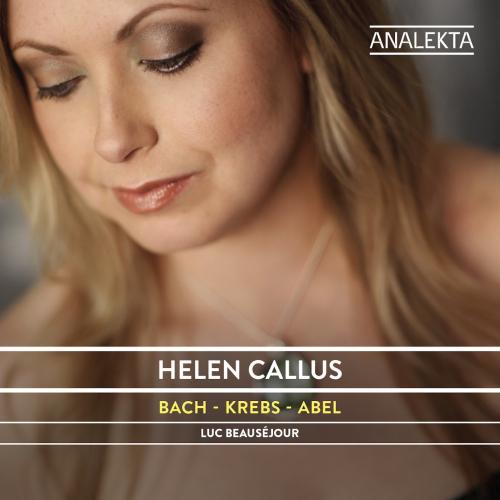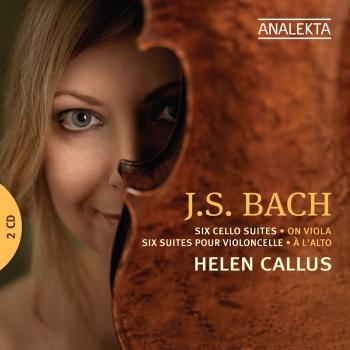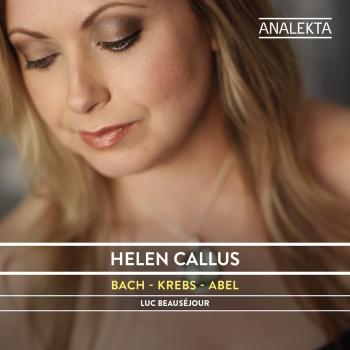
Bach - Krebs - Abel Helen Callus
Album info
Album-Release:
2015
HRA-Release:
28.11.2019
Label: Groupe Analekta, Inc
Genre: Classical
Subgenre: Chamber Music
Artist: Helen Callus
Composer: Johann Sebastian Bach (1685-1750), Carl Friedrich Abel (1723-1787), Johann Ludwig Krebs (1713-1780)
Album including Album cover
- Johann Sebastian Bach (1685 - 1750): Sonata No. 2 in D Major for Obbligato Harpsichord and Viola da Gamba, BWV 1028:
- 1 Sonata No. 2 in D Major for Obbligato Harpsichord and Viola da Gamba, BWV 1028: I. Adagio 02:12
- 2 Sonata No. 2 in D Major for Obbligato Harpsichord and Viola da Gamba, BWV 1028: II. Allegro 03:52
- 3 Sonata No. 2 in D Major for Obbligato Harpsichord and Viola da Gamba, BWV 1028: III. Andante 04:49
- 4 Sonata No. 2 in D Major for Obbligato Harpsichord and Viola da Gamba, BWV 1028: IV. Allegro 04:33
- Sonata No. 3 in G Minor for Obbligato Harpsichord and Viola da Gamba, BWV 1029:
- 5 Sonata No. 3 in G Minor for Obbligato Harpsichord and Viola da Gamba, BWV 1029: I. Vivace 05:10
- 6 Sonata No. 3 in G Minor for Obbligato Harpsichord and Viola da Gamba, BWV 1029: II. Adagio 06:31
- 7 Sonata No. 3 in G Minor for Obbligato Harpsichord and Viola da Gamba, BWV 1029: III. Allegro 04:06
- Sonata No. 1 in G Major for Obbligato Harpsichord and Viola da Gamba, BWV 1027:
- 8 Sonata No. 1 in G Major for Obbligato Harpsichord and Viola da Gamba, BWV 1027: I. Adagio 04:05
- 9 Sonata No. 1 in G Major for Obbligato Harpsichord and Viola da Gamba, BWV 1027: II. Allegro ma non tanto 03:29
- 10 Sonata No. 1 in G Major for Obbligato Harpsichord and Viola da Gamba, BWV 1027: III. Andante 02:50
- 11 Sonata No. 1 in G Major for Obbligato Harpsichord and Viola da Gamba, BWV 1027: IV. Allegro moderato 03:17
- Johann Ludwig Krebs (1713 - 1780): Trio in C Minor for Two Claviers and Bass, WV 473:
- 12 Trio in C Minor for Two Claviers and Bass, WV 473: I. Andante 07:21
- Carl Friedrich Abel (1723 - 1787): Sonata No. 2 in E Minor, WKO 150:
- 13 Sonata No. 2 in E Minor, WKO 150: I. Siciliano 02:44
- 14 Sonata No. 2 in E Minor, WKO 150: II. Allegro 03:31
- 15 Sonata No. 2 in E Minor, WKO 150: III. Presto 02:43
Info for Bach - Krebs - Abel
The present recording brings together music by Johann Sebastian Bach with works by his students Carl Friedrich Abel and Johann Ludwig Krebs, composers who were not only friends and associates of Bach, but also members of families with which Bach was closely connected. These pieces show the many ways in which Bach was connected to his students, including writing music for them to perform, aiding them in finding employment, and promoting their music.
Bach’s three Sonatas for Viola da gamba and continuo were probably composed between 1736 and 1741, during the time when Bach was working in Leipzig. In addition to his duties as Kantor of the Thomasschule, Bach became the director of the Leipzig collegium musicum in 1729. This group of professional musicians and university students gave concerts at least once a week, either in Gottfried Zimmermann’s coffee house, or in his garden outside the city in the summer. Bach composed music for this group, and made new arrangements of earlier compositions. The gamba sonatas may have been amongst these arrangements. The G major sonata also exists in a version, almost certainly earlier, for two flutes and continuo, and the G minor sonata is most likely an arrangement of a now-lost concerto in the style of the Brandenburg Concertos.
This very instrument, the viola da gamba, provides the link between Bach and the Abel family. Carl Friedrich’s father, Christian Ferdinand Abel, was a viol player in the service of Prince Leopold I of Anhalt-Cöthen, who was particularly fond of the viol. Bach joined him in the Prince’s service in 1717, and the two musicians became close friends, with Bach standing as godfather to Abel’s first daughter. The younger Abel, also a gamba virtuoso, moved to Leipzig after his father’s death, where he may have worked with Bach. Carl Friedrich Abel remained close to the Bach family for almost his entire life, working with Bach’s son Wilhelm Friedemann in Dresden in the 1740s before moving to London, where he shared a home with Johann Christian Bach, and with whom he founded the first subscription concert series in England. It is possible that the Bach gamba sonatas were arranged for one of the Abels, either for the father in Cöthen, or, as now seems more probable, for the son in Leipzig. Abel’s own Sonata in E minor comes from very late in his career, and was probably composed for a trip to Postdam and Berlin in 1782, presumably to impress Friedrich Wilhelm II, Crown Prince of Prussia and a gamba player himself in his youth.
Bach’s association with the Krebs family began even earlier than his friendship with the Abels. Johann Tobias Krebs, only five years younger than Bach, was an organist who studied with Bach in Weimar from about 1714 to 1717, and who also copied much of Bach’s keyboard music. Krebs’s son Johann Ludwig, also an organist, was a student at the Leipzig Thomasschule during Bach’s time there, and seems to have been an especially prized pupil. Bach wrote a testimonial for the younger Krebs around the time that he graduated from the Thomasschule, praising him as a composer, and stressing his qualifications on the clavier, violin and lute, and concluding by “recommending him most heartily”. A pun attributed to Bach himself said that “in this great stream [Bach] only a single crab [Krebs] has been caught”. After his graduation, Krebs continued to assist Bach at the Thomasschule and to play harpsichord for the collegium musicum. Like his father, Krebs copied music for Bach, and many important sources, especially for cantatas, are in his hand. Krebs has even been proposed as the composer of some keyboard works once attributed to Bach. Conversely, Bach also promoted Krebs’s work, offering a collection of Krebs’s keyboard works for sale alongside compositions of Bach’s own and of his sons as part of a book and music sales business. The Trio in C minor is an organ work, and is a trio in the sense that it is constructed from three musical lines, two played on the manuals of the organ, and one by the pedals. Krebs had a two-manual organ at his disposal at the castle church in Altenburg, where he was organist from 1755, an instrument that he “loved more than a father”.
Although there is no evidence that Bach, Abel and Krebs were ever in the same place at the same time, it is far from impossible that such a meeting took place. Both Abel and Krebs were in Leipzig around 1737, and it seems not entirely fanciful to imagine Abel, the great gamba player of his age, playing three freshlyarranged sonatas by his new teacher next to Krebs at the harpsichord, with Bach sitting proudly in attendance at Zimmermann’s coffee house.
Helen Callus, viola
Luc Beauséjour, harpsichord
Helen Callus
Hailed as “one of the world’s greatest violists” (American Record Guide), and “one of the foremost violists of her generation” (Fanfare magazine), Helen Callus continues to captivate audiences with her lyrical tone, technical command, and profound artistry.
Sought after as a recitalist, chamber musician, and concerto soloist, Ms. Callus has performed with such world-class ensembles as the Tokyo and Juilliard String Quartets and the BBC Concert Orchestra, and delighted audiences around the world, in Russia, Europe, New Zealand, Australia, Canada, and throughout the US.
Ms. Callus’s career includes distinguished work as an award-winning recording artist. Her seven releases include the works of Walton, Prokofiev, Vaughn Williams, J.S. Bach, Gordon Jacob and more, and have been met with high critical acclaim. The American Record Guide observed, “Only really great artistry can hold a listener in thrall like that, and that is the artistry of Helen Callus”.
Ms. Callus currently holds the appointment of Professor of viola at the University of California, Santa Barbara, and has recently accepted an invitation to join the faculty of the prestigious Colburn Young Artists Academy in Los Angeles. Sought after as a visiting professor, she has given over 80 master classes at many of the world’s leading schools of music. She also served as the first female President of the American Viola Society.
Born in England, Ms. Callus graduated from London’s Royal Academy of Music, and was bestowed an Honorary ARAM and FRAM for her achievements in the field. She continued her graduate studies at the Peabody Conservatory.
Ms. Callus plays on a viola made for her by Gabrielle Kundert which is a copy of the ex-Primrose Amati.
This album contains no booklet.












